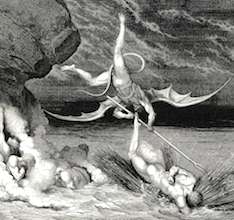In the sixth chapter of St. Mark’s Gospel, we find the account of Jesus sending out the Twelve, two by two, on mission. The first thing he gave them, Mark tells us, was “authority over unclean spirits.” And the first pastoral act that they performed was to “drive out many demons.” When I was coming of age in the ‘60s and ‘70s, it was common, even in seminaries, to dismiss such talk as primitive superstition—or perhaps to modernize it and make it a literary device, using symbolic language evocative of the struggle with evil in the abstract. But the problem with that approach is that it just does not do justice to the Bible. The biblical authors knew all about “evil” in both its personal and institutional expressions, but they also knew about a level of spiritual dysfunction that lies underneath both of those more ordinary dimensions. They knew about the world of fallen or morally compromised spirits. Jesus indeed battled sin in individual hearts as well as the sin that dwelt in institutional structures, but he also struggled with a dark power more fundamental and more dangerous than those.
What, or better, who is this threatening spiritual force? It is a devil, a fallen or morally compromised angel. Imagine a truly wicked person who is also very smart, very talented and very enterprising. Now raise that person to a far higher pitch of ontological perfection, and you will have some idea of what a devil is like. Very rarely, devils intervene in human affairs in vividly frightening and dramatic ways. But typically, devils act more indirectly and clandestinely, through temptation, influence and suggestion. One of the most terrifying religious paintings in the world is in the Cathedral of Orvieto in Italy. It is a depiction of the Antichrist by the great early renaissance painter Luca Signorelli. The artist shows the devil whispering into the ear of the Antichrist, and also working his arm through the vesture of his victim in such a way that it appears to be the Antichrist’s own arm, thereby beautifully symbolizing how the dark power acts precisely with us and through us.
What are his usual effects? We can answer that question quite well by examining the names that the Bible gives to this figure. He is often called diabolos in the Greek of the New Testament, a word derived from dia-balein, to throw apart, to scatter. God is a great gathering force, for by his very nature he is love; but the devil’s work is to sunder, to set one against the other. Whenever communities, families, nations, churches are divided, we sniff out the diabolic. The other great New Testament name for the devil is ho Satanas, which means “the accuser.” Perform a little experiment: gauge how often in the course of the day you accuse another person of something or find yourself accused. It’s easy enough to notice how often dysfunctional families and societies finally collapse into an orgy of mutual blaming. That’s satanic work. Another great biblical name for the devil is “the father of lies.” Because God is Truth, truthfulness—about oneself, about others, about the way things really are—is the key to smooth human relations. But how often we suffer because of untruth! Perhaps many years ago, someone told you a lie about yourself, and you’ve been wounded by it ever since. Perhaps you’ve deliberately lied about another person and thereby ruined his character and reputation. Consider how many wars and genocides have been predicated upon pervasive misperceptions and fabrications. Finally, the author of the first letter of John refers to the devil as “the murderer from the beginning.” God is life and thus the fosterer of human life. The devil—like an unhappy person who likes nothing better than to spread unhappiness around him—is the enemy of human flourishing, the killer of life. Does anyone really think that the massive slaughters that took place in the twentieth century—the piling up of tens of millions of corpses—can be adequately explained through political or psychological categories?
An extraordinarily important aspect of the good news of Christianity is that Jesus, through his death and resurrection, has won victory over these dark forces. St. Paul said that we battle, not simply flesh and blood, but spiritual powers and principalities. But then he reminded us that nothing—neither height nor depth, nor any other power—could finally separate us from the love of Christ. Jesus has entrusted to his Church the means to apply this victory, the weapons, if you will, to win the spiritual warfare. These are the sacraments (especially the Eucharist and Confession), the Mass, the Bible, personal prayer, the rosary, etc. One of the tragedies of our time is that so many Catholics have dropped those weapons. Allow me to focus a bit more attention on Confession by switching from a military to a medical analogy. An open wound—untreated and un-bandaged—will rapidly become infected by germs and bacteria. Think of a pattern of serious sin as a sort of open wound in the spiritual order. Untreated, which is to say, un-confessed, it becomes a point of entry for less than savory spiritual powers.
Jesus sent out the Twelve to battle dark spirits. He still empowers his church to do the same. Don’t be reluctant to use the weapons—and the healing balms—that he has given.
